Hello! This week, I made my own herbal powders from whole, organic, recently harvested herbs for the first time! Once I opened the packages with the Motherwort leaves and Hawthorn berries, the inspiring process of creation has started!
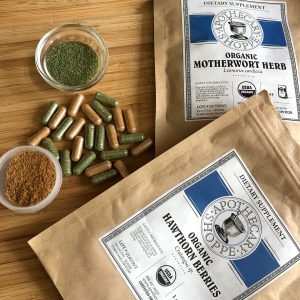
I used a mortar and pestle and Vitamix blender to crush and pulverize all components of these herbs into a fine powder. Both of these herbal powders smelled and tasted so fresh and looked so bright!
The Hawthorn Berries powder and capsules:
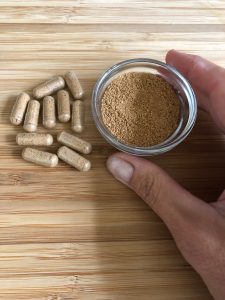 Modern herbal therapy implements Hawthorn berries, leaves, and flowers. The Hawthorn plant has beneficial cardiovascular effects* (Holubarsch, Colucci, & Eha, 2018).
Modern herbal therapy implements Hawthorn berries, leaves, and flowers. The Hawthorn plant has beneficial cardiovascular effects* (Holubarsch, Colucci, & Eha, 2018).
The Motherwort powder and capsules: The Motherwort plant has anti-inflammatory, antioxidative, antimicrobial, tissue-protective, and sedative effects* (Fierascu et al., 2019).
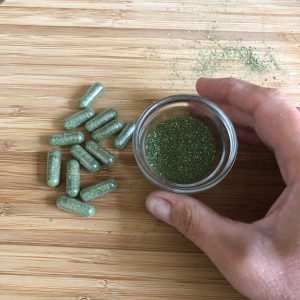 I used to take herbal powders prepared by the Ayurvedic practitioners as a Complementary and Alternative Medical (CAM) approach for different purposes: to relieve stomach discomfort, alleviate muscle pain, improve digestion and elimination, decrease stress, and reduce congestion* (Patwardhan, 2014). I loved Ayurvedic herbal preparations! Each one smelled and tasted differently and affected my body and mind in a positive way.
I used to take herbal powders prepared by the Ayurvedic practitioners as a Complementary and Alternative Medical (CAM) approach for different purposes: to relieve stomach discomfort, alleviate muscle pain, improve digestion and elimination, decrease stress, and reduce congestion* (Patwardhan, 2014). I loved Ayurvedic herbal preparations! Each one smelled and tasted differently and affected my body and mind in a positive way.
The herbal powders can be taken in a powdered form or as capsules. The herbal powders made at home can be the purest and the freshest ones, as you can select the best quality herbs (organic, wild-crafted, or even home-grown) and the best quality capsules while avoiding any other ingredients that seem unnecessary (fillers, pesticides, additives, preservatives, etc.). I was pleasantly surprised when I discovered that the Apothecary Shoppe listed the date of the harvest on each package with whole herbs. You can make the herbal powders in small batches to ensure freshness and maximum potency and prevent rancidity. Each batch can be stored in a refrigerator with a moisture absorbent packets.
It is best to contact a Certified Herbalist, an Ayurvedic Practitioner, or Naturopathic Doctor to inquire which herbs can be a good fit for your body as a part of the CAM approach to healing and wellness. In the United States, about 38% of adults (every 4 in 10) and 12% of children (every 1 in 9) are using some type of CAM.
The most common forms of CAM used in the U.S. include nutrition and diet-based therapy, herbs, Yoga, Pilates, Ayurveda, Traditional Chinese Medicine, energy healing/Reiki, and many others (John Hopkins Medicine, 2019; NIH, 2017). The CAM approaches are non-mainstream and can be used together with conventional mainstream medicine (NIH, 2019).
Contact me today to discuss your nutrition goals! Our initial 20-minute discussion is free of charge. To help you succeed with your health and wellness goals, I offer holistic nutrition consultations as well as wellness coaching.
References:
Fierascu, R. C., Fierascu, I., Ortan, A., Fierascu, I. C., Anuta, V., Velescu, B. S., … Dinu-Pirvu, C. E. (2019). Leonurus cardiaca L. as a Source of Bioactive Compounds: An Update of the European Medicines Agency Assessment Report (2010). BioMed Research International, 2019, 4303215. doi:10.1155/2019/4303215
Holubarsch, C., Colucci, W. S., & Eha, J. (2018). Benefit-Risk Assessment of Crataegus Extract WS 1442: An Evidence-Based Review. American Journal of Cardiovascular Drugs : Drugs, Devices, and Other Interventions, 18(1), 25–36. doi:10.1007/s40256-017-0249-9
John Hopkins Medicine. (2019). Types of Complementary and Alternative Medicine. Retrieved from https://www.hopkinsmedicine.org/health/wellness-and-prevention/types-of-complementary-and-alternative-medicine
NIH National Center for Complementary and Integrative Health. (2017). The use of Complementary and Alternative Medicine in the United States. Retrieved from https://nccih.nih.gov/research/statistics/2007/camsurvey_fs1.htm
NIH National Center for Complementary and Integrative Health. (2019). Complementary, Alternative, or Integrative Health: What’s in a Name? Retrieved from https://nccih.nih.gov/health/integrative-health
Patwardhan, B. (2014). Bridging Ayurveda with evidence-based scientific approaches in medicine. The EPMA Journal, 5(1), 19. doi:10.1186/1878-5085-5-19
*These statements have not been evaluated by the Food and Drug Administration. These products are not intended to diagnose, treat, cure, or prevent any disease. This information is for educational purposes only.

 Today, I’m sharing with you one of my favorite recipes – the quinoa pancakes.
Today, I’m sharing with you one of my favorite recipes – the quinoa pancakes.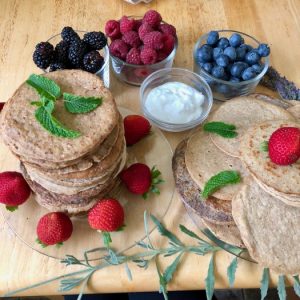 You will need the following ingredients:
You will need the following ingredients: What I love about this recipe is that the pancakes have a neutral taste and can be enjoyed with both sweet and savory meals or snacks. As a sweet version, I like to serve them with berries, fruits, and coconut yogurt. For a savory twist, I serve them with veggies, salads, and dressings (taco-like style). On this image below, you can see 3 pancakes, each served with the arugula leaves, slices of tomato and red onion, and avocado cubes. In this version, the pancakes work as flatbreads or soft tacos.
What I love about this recipe is that the pancakes have a neutral taste and can be enjoyed with both sweet and savory meals or snacks. As a sweet version, I like to serve them with berries, fruits, and coconut yogurt. For a savory twist, I serve them with veggies, salads, and dressings (taco-like style). On this image below, you can see 3 pancakes, each served with the arugula leaves, slices of tomato and red onion, and avocado cubes. In this version, the pancakes work as flatbreads or soft tacos. 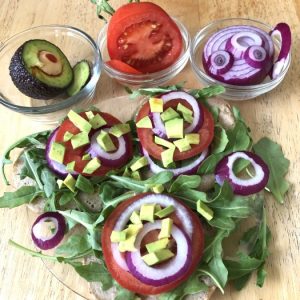 Additionally, I soaked and sprouted the quinoa seeds, which is an easy step that can improve the digestibility and nutrient availability. Moreover, soaked and sprouted quinoa gives you more pancakes if compared with those made from the unsoaked quinoa. Note that this recipe does not need any flour; the whole quinoa seeds were soaked and sprouted and blended together with banana, flax seeds, and water. Here is a full recipe, enjoy!
Additionally, I soaked and sprouted the quinoa seeds, which is an easy step that can improve the digestibility and nutrient availability. Moreover, soaked and sprouted quinoa gives you more pancakes if compared with those made from the unsoaked quinoa. Note that this recipe does not need any flour; the whole quinoa seeds were soaked and sprouted and blended together with banana, flax seeds, and water. Here is a full recipe, enjoy!